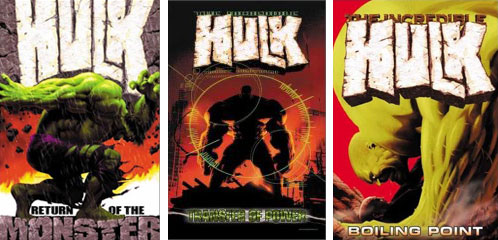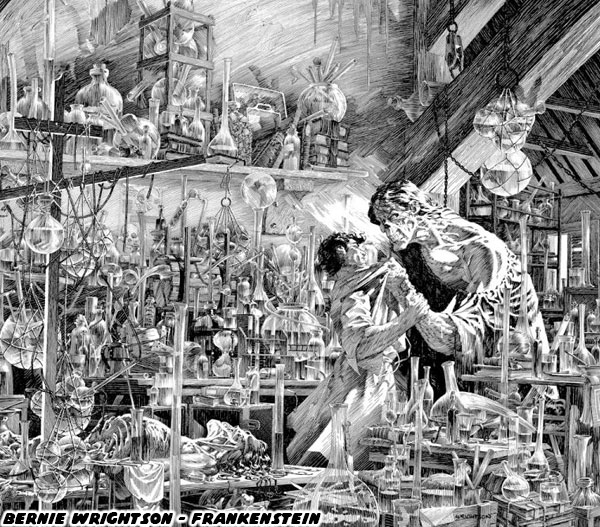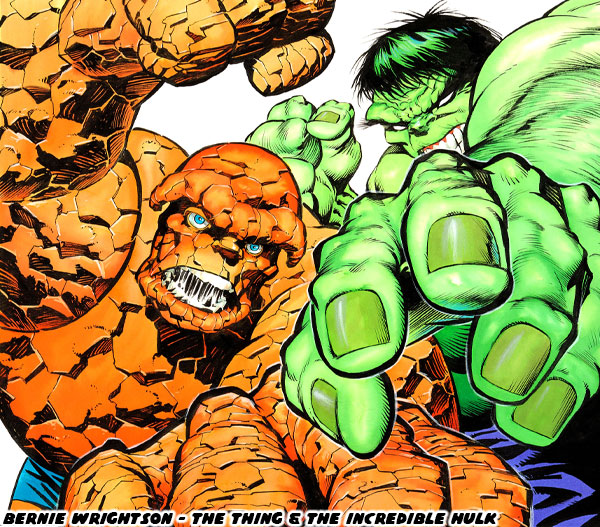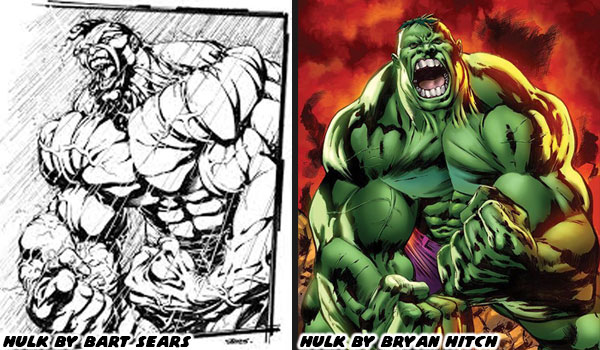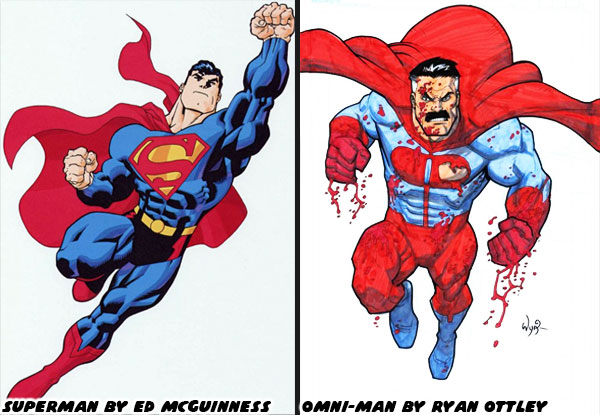When I talk about fighting game character designs I usually start with martial artists, and particular styles. Sometimes we look at the pop culture influences behind these designs. Today we’re going to look at the horror, and science fiction roots of a certain character type. The artificial human, the man created by science. We’re familiar with the story, which is as old as Mary Shelley’s original work Frankenstein; or, The Modern Prometheus. The book from 1818 has been adapted thousands of times, from stage plays, to cartoons, and live action movies. In the story Dr. Victor Frankenstein pieces together a man made from different cadavers, and then brings it to life. He abandons his creation, and the monster is shunned by society because of his grotesqueness. The monster makes it his mission to track down his creator and destroy him. It’s a cautionary tale with many different lessons, one of the most important is what happens to science without ethics.

The creature turning against the creator is the backbone of science fiction. The Terminator movie series is not far removed from the story of Frankenstein. In the movies Cyberdyne Systems loses control of its artificial intelligence SKYNET network. Without the military issuing commands the T-800 robots almost wipe out humanity. The robots covered in organic flesh are very lifelike, and each revision becomes harder and harder for humans to detect. Now the question is whether or not the fighting game genre has ever given audiences a Frankenstein's monster. The short answer is yes, of course it has. Many times in fact. The Terminator appeared in Mortal Kombat 11, the NetherRealm title from 2019. A more literal Frankenstein's monster appeared with Victor Von Gerdenheim in 1994's Vampire / Darkstalkers by Capcom. Yet there were more examples of the humanoid mechanical fighter that were poached by studios.

In the film Terminator 2: Judgement Day (1991) the next variation of the cyborg, the T-1000 is made of a liquid metal that allows it to mimic any person, or object. The special effects by Industrial Light and Magic were revolutionary. It was the first time that life-like CGI and practical effects blended seamlessly in a big budget Hollywood movie. The visuals of the T-1000 inspired a generation of artists, animators, and producers. The idea of putting a Terminator-like character in a fighting game were not far behind.
Battle K-Road by Psikyo was a 1994 fighting game that
poached heavily from actual fighters, and pop culture. It was notable for using a cyborg that was a dead ringer for Arnold Schwarzenegger from the original 1984 Terminator film. Aside from that, the T-1000 was far more interesting to fighting game developers. The idea that one character could mimic the moves of every fighter was an interesting premise. Of course a fighter that could do this would be overpowered, and not someone that studios would want to make playable. That is possibly why the first character that was poured from the T-1000 mold was Geegus. The silver-skinned boss character from the game World Heroes debuted in 1992. The developers at ADK were coming out with a number of the early brawling, and fighting game hits for the Neo Geo platform.

World Heroes was one of the first, if not the first, time-traveling fighting games. It took a number of characters from history, not all necessarily fighters, and put them in a tournament to determine who was the greatest hero. Geegus was an alien using the tournament as a front to observe, and absorb the moves of every participant. This became a popular trend as other boss characters appeared that were more of less the same. Dural from Virtua Fighter (1993) by SEGA, was the next similar boss design. She had the moves of every fighter in the tournament. This cyborg was based on a human kunoichi, or female ninja fighter. She was the first 3D female boss in a game. The first female boss that predated her (that I know of) was Mizuki Rashojin, who appeared in Samurai Showdown II just a month earlier. Dural could not melt and change shape like Geegus, but the silver skin was nonetheless an impressive technological feat for the time.

The fighting game genre was exploding in the early ’90s. The technology used in arcades was transitioning from sprite to polygon. Rare was on the cutting edge of graphics at the time. They released Killer Instinct in 1994. The game used Silicon Graphics workstations (then the most powerful engines for 3D effects) to create their models, and stages. The game featured a number of fighting archetypes, but one of the most memorable was the alien Glacius. This character did not have the ability to mimic the moves of his opponents, but he was like the T-1000 in that he could change shape. In the Terminator film the T-1000 could turn his appendages into spikes, go completely flat, and slide past opponents. Rare demonstrated that the shape-shifting moves from the film could work in a fighting game.

The challenge was on for the developers. Could they create a playable character that could mimic his opponents without being overpowered? Capcom was up to the task, but their first attempt at creating a move-stealing fighter wasn’t seen by the majority of their fans. The Cyborg appeared in the 1995 game, Street Fighter II: The Interactive Movie. The evil Shadowlaw cyborgs were featured in the SF II animated movie, as they observed, and reported back to Vega (Dictator). In the game the character would learn the special attacks of the fighters at various points in the movie. The robot potentially had the ability to use the super fireball of Ryu, the super dragon punch of Ken, and even the sweeping kicks of Chun-Li. The seven-foot cyborg was essentially the first original Frankenstein's monster in the genre. Although it was a villain, an alternate ending in the game saw the Cyborg turn against Shadowlaw and destroy Vega. Sadly the character wouldn’t appear in another Street Fighter game, but its DNA would be revisited.

A good number of the team members responsible for Street Fighter II wanted to take a crack at the cybernetic mimic. They formed a new studio called ARIKA. They came up with two new characters; Cycloid β (Beta), and Cycloid γ (Gamma). The robots appeared in Street Fighter EX, the original 3D SF game at the end of 1996. What ARIKA did to keep their Cycloids from being overpowered was to give each of them moves from half the cast. In this way they had an even mix of close, mid range, and distance attacks. They also had unique combos that no other character could perform. Their move selection was very much pieced together like Frankenstein. Although they could not shape shift, they were still memorable attempts at making synthetic fighters.

Not to be outdone Capcom wanted to take another crack at the shape shifting, and move stealing monster. Their next attempt would be the last time they developed a sprite-based character. Twelve debuted in Street Fighter III: 3rd Strike. The game from 1999 was the last numbered Street Fighter to use traditional hand-drawn sprites. This character was very flexible, and rubbery, even when compared to Necro from the same game. Twelve was not completely fluid, like Geegus or Glacius, he couldn’t exactly flow like water. The animators at Capcom gave him the illusion of weight, and mass, like a rubber tire, rather than a ball of mercury. It could still change shape. The synthetic life form could turns its appendages into blades, or whips. It could glide, and even spring around the stage. In order to prevent Twelve from being overpowered it could only mimic the moves of the character it was currently fighting. It was easily one of the best animated characters from any fighting game, and possibly the closest thing to being a playable T-1000. As far as Frankenstein creatures went, it was a trained weapon, not exactly going against its creators.

Namco had been focused on their own characters, and designs with the Tekken series. They weren’t interested in silver-skinned, bald men as bosses. They already had cyborgs like Jack and P-Jack that were above and beyond the T-800. Their
magically animated wooden fighter Mokujin could also emulate its opponent. In 2001 the studio finally decided to create a dedicated robot capable of stealing the moves of its opponent. Combot appeared first in Tekken 4. It was not covered in liquid metal like the T-1000. It looked more like a traditional robot than any other fighter listed thus far. The studio had been paying attention to what Capcom, and ARIKA had done. The character could only mimic the moves of its current opponent. It was a great choice if you wanted to learn the nuances of each character in arcade mode.

The start of the new millennium was pretty quiet for the fighting game community. All of that changed in 2008 with the release of Street Fighter IV. Capcom was eager to get audiences back into the genre and they did so by reintroducing the original World Warriors. The studio also created a new boss that was a call back to Geegus. Seth was the silver-skinned humanoid perfected. The character was the President of S.I.N. the weapons development unit of Shadowlaw. His team used his body to build the perfect weapon. He could emulate, and reflect both special, and super attacks from the fighters he crossed. The character was visually unique, with a rotating power source where his abdomen should be. In the game story it was explained that the Shadowlaw scientists had been able to
recreate the moves of the masters using the Tanden Engine. Daigo Ikeno, lead designer on Street Fighter IV pulled a lot of visual elements from Shinto, and Tao spiritual beliefs, and turned them into pseudo-scientific technology.

Capcom didn’t do much in the way of changing the Seth or developing a new boss character over the next decade. The standard had been set early on. Seth was arguably the best original Frankenstein's monster in the genre. Even better because this was as if Victor Frankenstein had built the monsterous body to drop his brain into. In 2019 Capcom decided to revisit Seth for Season Four of Street Fighter V: Champion Edition. This time the re-skinned Seth was also assigned a new gender. I’m not sure how much forethought was given to this idea, but I’d like to think it was a progressive statement from Capcom. The change of Seth from a male to female body was written into the story, as the cyborg had its consciousness transferred to a new body. This new form rounded out the abilities of the character, and if anything, made it even more interesting.

The Tanden Engine, was powered by Yin and Yang energy. The opposing forces were required to achieve balance. Being gender-neutral made Seth able to explore both sides of this power source. The duality could be seen in the concept art, as well as in the final design of both versions of Seth. Her standing lotus pose was a call back to the original seated position of the character. But the details in the updated Seth went much deeper than that. Seth’s new haircut covered half her face, literally making it half light, and half dark. A mirrored yin and yang symbol from her stomach. The circular hair bun completed the look.
The use of knots, braids, and ropes for the various character costumes were pulled right from Shinto beliefs. These details
were covered previously on the blog.
I mentioned how the knots worn on the belts of Gouken, and Gouki had symbolic meanings. The same could be attributed to the hair of Seth. Capcom had created both the genre's original Frankenstein's Monster, and the Bride of Frankenstein with this fighter. Seth in either male or female form was far more powerful, and dangerous than any human. Its creators at S.I.N. had propelled science beyond human understanding. By doing so they created a villain that was immortal, essentially god-like.

The connections to Seth and godhood were not a coincidence. In earlier concept art the designers at Capcom were considering adding a flowing scarf, and top knot. This look was a direct call out to Raijin, the Shinto god of thunder. Audiences were supposed to tell instantly that this was a powerful villain. In many classical paintings, and even statues, Raijin was presented with a flowing scarf. Sometimes holding a vajra, a type of dagger used for striking down evil. The poses, and figures from Buddhism, complimented the Shinto beliefs in Japan. The poses and iconography are sometimes blended together, and easily recognized in Asian countries. While fans in the West may not get all of the mythology behind Seth’s details, they are nonetheless interesting to study and learn from.

We have the technology to create an actual T-1000 character in a fighting game, one that could change shape, and use all of the special attacks of the cast. Time has shown us that such a character would be far too powerful to be anything but a boss design. So for the help of balancing the roster the studios have learned to tone down their moves and abilities. At least Capcom, Namco, ARIKA, and DIMPS learned what Dr. Frankenstein never could. Don't build a monster that you cannot control! What do you think of move-stealing cyborgs in fighting games? Are you for them? Against them? Let me know in the comments section. If you would like to sponsor me
please visit my Patreon page and consider donating each month, even as little as $1 would help make better blogs and even podcasts!